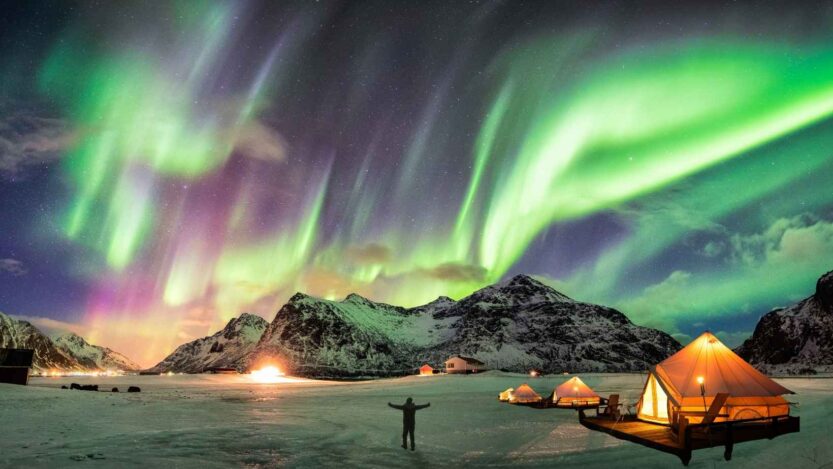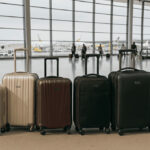Why the Northern Lights and Aurora Borealis Are a Must-See in 2025
The Northern Lights, also known as the Aurora Borealis, are one of the most breathtaking natural wonders of our planet. Imagine green, purple, and red lights dancing across the night sky it’s a magical experience that feels like stepping into another world. In 2025, travel to see the Aurora Borealis is expected to be more popular than ever, as solar activity peaks and makes the displays brighter and more frequent.
If you’ve been dreaming of this bucket-list adventure, this guide will show you the top 10 countries to see Northern Lights and Aurora Borealis in 2025. We’ll cover everything from the best time to visit, average cost per day, temperature range, ease of travel, and even whether you need special transport like helicopters to reach the viewing spots. We’ll also highlight our Top 3 Picks for 2025.

Top 10 Countries to See Northern Lights and Aurora Borealis
1. Norway – Tromsø and Svalbard
- Best Time: September to March
- Average Cost: $250–$350 per day for 2–3 days (mid-range hotels + tours)
- Temperature: –5°C to –20°C
- Ease of Visit: Very easy; Tromsø has direct flights from Oslo/London.
- How to Get There: Flight to Tromsø; no helicopters needed. Bus tours or snowmobiles take you to clear-sky spots.
- Why Visit: Norway is considered the “Capital of the Northern Lights.” Svalbard offers polar bear sightings with the Aurora.
- Age Group: 10+ (kids and adults welcome).
2. Iceland – Reykjavik and Thingvellir
- Best Time: September to April
- Average Cost: $200–$300 per day
- Temperature: –2°C to –10°C
- Ease of Visit: Easy; Reykjavik is well-connected by air.
- How to Get There: Flight to Reykjavik; bus/car rentals to rural viewing points. No helicopters required.
- Why Visit: Combine Aurora Borealis with natural hot springs and ice caves.
- Love Factor: Very high; perfect for couples on honeymoon.
3. Sweden – Abisko National Park
- Best Time: November to March
- Average Cost: $220–$280 per day
- Temperature: –10°C to –25°C
- Ease of Visit: Moderate; flight to Kiruna then train/car to Abisko.
- How to Get There: No helicopters needed; trains run directly to Abisko.
- Why Visit: Famous “Blue Hole” sky gives clear aurora chances.
- Top Pick: One of the best-value destinations.
4. Finland – Lapland
- Best Time: December to March
- Average Cost: $250–$400 per day
- Temperature: –15°C to –30°C
- Ease of Visit: Easy; Rovaniemi airport connects to major European cities.
- How to Get There: Flights to Rovaniemi; reindeer sleds, snowmobiles for local tours.
- Why Visit: Glass igloos let you watch the Aurora Borealis from your bed.
- Family Friendly: Yes, Santa Claus Village makes it perfect for kids.
5. Canada – Yukon, Yellowknife
- Best Time: November to March
- Average Cost: $220–$280 per day
- Temperature: –20°C to –35°C
- Ease of Visit: Moderate; flights to Yellowknife/Whitehorse.
- How to Get There: Flights only; guided tours use cars or buses.
- Why Visit: Wide open skies, fewer crowds. Aurora Borealis guaranteed.
- Emergency Care: Excellent Canadian medical system.
6. Alaska (USA) – Fairbanks
- Best Time: September to April
- Average Cost: $200–$270 per day
- Temperature: –15°C to –30°C
- Ease of Visit: Easy; flights to Fairbanks from Seattle/Anchorage.
- How to Get There: Local buses or aurora-chasing tours; no helicopters required.
- Why Visit: Less touristy than Europe, with affordable packages.
7. Greenland – Kangerlussuaq
- Best Time: September to March
- Average Cost: $300–$400 per day
- Temperature: –20°C to –40°C
- Ease of Visit: Challenging; flights mainly from Denmark or Iceland.
- How to Get There: Flight to Nuuk or Kangerlussuaq; local tours by snowmobile.
- Why Visit: Remote, raw, and uncrowded aurora viewing.
- For Adventurers Only.
8. Scotland – Isle of Skye, Cairngorms
- Best Time: December to February
- Average Cost: $180–$250 per day
- Temperature: 0°C to –5°C
- Ease of Visit: Very easy; drive/train from Edinburgh/Glasgow.
- How to Get There: No helicopters required.
- Why Visit: Budget-friendly, plus whisky tours.
- Best for Weekend Travelers.
9. Russia – Murmansk & Siberia
- Best Time: December to March
- Average Cost: $200–$280 per day
- Temperature: –20°C to –40°C
- Ease of Visit: Moderate; flights to Murmansk from Moscow/St. Petersburg.
- How to Get There: Cars and snow tours; no helicopters required.
- Why Visit: Wild and untouched landscapes with dramatic aurora skies.
10. Estonia – Lahemaa National Park
- Best Time: November to March
- Average Cost: $150–$220 per day
- Temperature: –5°C to –15°C
- Ease of Visit: Easy; short flight from most of Europe to Tallinn.
- How to Get There: Car rentals, buses.
- Why Visit: Budget-friendly entry into aurora chasing.
🌟 Top 3 Picks for 2025
- Norway – Tromsø (Best Overall)
- Sweden – Abisko (Best Value)
- Finland – Lapland (Most Romantic)
FAQs about Northern Lights and Aurora Borealis
Q1. Do I need a helicopter to reach Northern Lights destinations?
No. Most countries are accessible by flights and local ground tours (cars, buses, snowmobiles). Helicopters are not necessary for aurora viewing.
Q2. What is the Aurora Borealis?
The Aurora Borealis is a natural light display caused by solar particles colliding with Earth’s atmosphere.
Q3. What’s the best age to visit?
Suitable for ages 10 and above. Young children may struggle with freezing temperatures.
Q4. Can I see the Northern Lights every night?
No, sightings depend on clear skies and solar activity. Booking at least 3 nights increases your chances.
Q5. How much does a full trip cost?
On average, a 3-day trip costs between $600–$1200 depending on country, lodging, and tours.
Chasing the Northern Lights and Aurora Borealis in 2025 is not just about ticking off a travel bucket list—it’s about experiencing pure wonder under the night sky. Whether you’re staying in a glass igloo in Finland or riding a snowmobile in Norway, this journey will leave you with lifelong memories.
For more travel inspiration, guides, and lifestyle tips, explore Lifney.com and other trusted travel resources.




